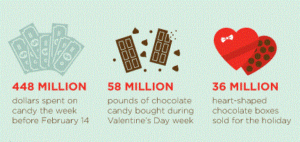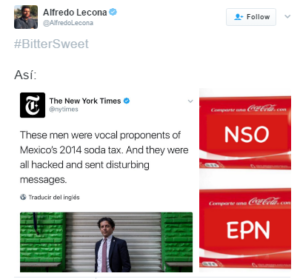Happy (healthy?) Valentine’s Day!
Happy Valentine’s Day!
It’s a big day for candy sales.

Just for fun, I Googled “healthy Valentine’s Day” just to see what would come up. Lots, it turns out.
Here’s my favorite.

Happy Valentine’s Day!

Happy Valentine’s Day!
It’s a big day for candy sales.

Just for fun, I Googled “healthy Valentine’s Day” just to see what would come up. Lots, it turns out.
Here’s my favorite.

Happy Valentine’s Day!
Who knew that such things existed, let alone that they would be directed at anti-obesity and pro-soda tax advocates.
The New York Times reports that frightening messages about their families (the article gives examples) were sent to the advocates with links
laced with an invasive form of spyware developed by NSO Group, an Israeli cyberarms dealer that sells its digital spy tools exclusively to governments and that has contracts with multiple agencies inside Mexico, according to company emails leaked to the New York Timeslast year.
Supposedly, this Group sells “tools only to governments for criminal and terrorism investigations.” These can “trace a target’s every phone call, text message, email, keystroke, location, sound and sight.”
As the Times gently puts it, this discovery “raises new questions about whether NSO’s tools are being used to advance the soda industry’s commercial interests in Mexico.”
Citizen Lab has more information about this situation.
The spyware targeted these individuals:
I am leaving on Wednesday for three weeks on a Fulbright to the National Institute of Public Health in Cuernavaca and hope to find out a lot more about this. Stay tuned.
In the meantime, here’s a tweet from someone I don’t know (I like the soda cans).
Late addition: Gary Ruskin sends his paper on corporate espionage against nonprofit organizations.
Jane Black sent me a link to her Huffington Post article on school lunches. As she puts it, “it’s a long read—perfect for a snowy weekend.
Indeed it is. Riveting, and brilliantly illustrated.
 This is Jane’s astonishingly well researched account of what happened to school meals in Huntington, West Virginia—after Jamie Oliver left.
This is Jane’s astonishingly well researched account of what happened to school meals in Huntington, West Virginia—after Jamie Oliver left.
Surprise: They got better!
The subtitle explains why: “How an unassuming bureaucrat outsmarted Jamie Oliver and pulled off an honest-to-god miracle in one of America’s unhealthiest cities.”
The conclusion:
What McCoy had done in Huntington was exactly the kind of thing Republicans claim to celebrate. She wasn’t a Washington bureaucrat telling people to do it her way, or no way at all; she was a well-intentioned local who had figured out what made sense for her community and acted on it.
This is a truly inspiring “yes we can” story, so worth reading—and so welcome.
Thanks Jane.
I am indebted to Food Chemical News (FCN) for this insight into the current lobbying efforts of the Council for Responsible Nutrition, the supplement industry’s relentless, never give up, trade group.
FCN says the Council is on track to visit all new congressional representatives with these asks:
Sigh.
Never mind that dietary supplements are hardly ever shown to improve health in healthy people, and not for lack of trying (see previous posts, below).
Never mind that this is an issue the USDA has been dealing with for years.
This industry sees the current political scene as favorable to supplements and is not going to miss this opportunity.
Oh well.
As you can see, I take a dim view of the value of supplements (yes, I know you love taking them, and how we all wish the science showed they did some good).
Here are some of my previous posts on supplements, if you want to catch up.
You may recall that one result of the fuss over the highly controversial BMJ article attacking the Dietary Guidelines process was appointment of a committee to review that process.
It has just published the first of its reports, which deals only with the first of the four charges to the committee, which were to determine:
1. How the selection process for the Dietary Guidelines Advisory Committee (DGAC) can be improved to provide more transparency, eliminate bias, and include committee members with a range of viewpoints;
2. How the Nutrition Evidence Library (NEL) is compiled and used, including whether the NEL reviews and other systematic reviews and data analysis are conducted according to rigorous and objective scientific standards;
3. How systematic reviews are conducted on long-standing DGAC recommendations, including whether scientific studies are included from scientists with a range of viewpoints; and
4. How the DGA can better prevent chronic disease, ensure nutritional sufficiency for all Americans, and accommodate a range of individual factors, including age, gender, and metabolic health.
The committee identified values governing the committee selection process:
Its recommendations:
Good recommendations and good luck with them.
I can hardly wait to see this committee’s report on the remaining charges.
In the meantime, it’s about time to start appointing the 2020 Dietary Guidelines Advisory Committee, no?
I’ve been collecting miscellaneous items about SNAP, particularly those related to USDA’s promised release of information about the amount of SNAP benefits spent at specific retail stores. Here’s the first:
The USDA alerted retailers that this information would be forthcoming (information about the legal challenges is here). A few weeks ago, the USDA said:
You may have been contacted by email, voicemail and/or text because you are a current or former SNAP authorized retailer, who participated between 2005 and the present, and FNS received a request for records that will disclose each of your store’s individual annual SNAP sales amounts. This information will be released promptly (i.e., approximately 12 calendar days from the email, voicemail, and/or text) to the public as the result of a court order.
But then the Food Marketing Institute (FMI) filed a motion to stop the release. Why? ” FMI seeks to preserve the confidentiality of sensitive data about the performance of its members’ stores.”
The court agreed to hear the appeal.
The USDA says it won’t release the information until the court case is resolved.
Why do you suppose the FMI does not want anyone to know how much money they get from SNAP purchases?
SNAP advocates have called for release of this information for years. The delays are frustrating.
We will know more in a couple of weeks.
Other items
I occasionally write about the food politics of marijuana-infused edibles.
Something new every day.
Here’s the latest veterinary problem: stoned dogs.
Dogs get into their owners’ edibles. Yum.
Veterinarians say they see cases of “canine marijuana poisoning” every day, with a big increase since 2010.
Pets get their own medical marijuana, as needed. But edibles cause emergency room visits.
This is all so complicated. You also have to make sure your kids don’t get into the drugs prescribed for your pets.
Lots to worry about. Have a great week.
John Germov & Lauren Williams, eds. A Sociology of Food & Nutrition: The Social Appetite, 4th ed. Oxford University Press, 2017.

I know about this book mainly because my NYU colleague Marie Bragg and I have a chapter in it, “The politics of government dietary advice: the influence of Big Food.”
The book is meant to introduce readers to the field of food sociology through themes. It divides chapters by various authors into three sections: the social appetite, the food system, and food culture.
Its aim is
to make the sociological study of food relevant to a multidisciplinary readership, particularly those across health, nutrition, and social science disciplines. Our further aim is to reach a broad readership so that those interested in food, nutrition, and wider issues of food production, distribution, and consumption can discover the relevance of studying the social context of food.
The chapters plunge into the controversies and come with summaries of the main points, sociological reflections, discussion questions, and ideas for further investigation.
The sociological reflection on Marie’s and my chapter says:
Dietary guidelines and food guides, although apparently “science-based,” are created by individuals who serve on government committees and are subject to the same kinds of influences as any other members of society. Because the food industry is the sector of society with the strongest stake in the outcome of dietary guidance, government agencies and committee members are strongly lobbied by industry. Controversy over dietary advice derives from the contradiction between the health-promoting goals of public health and the profit-making goals of food companies.
If you are looking for a quick introduction to food sociology, here’s a place to begin. The editors are Australian academics so there are plenty of Australian examples.